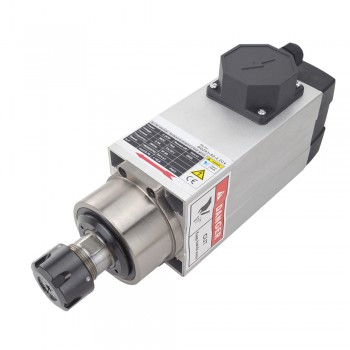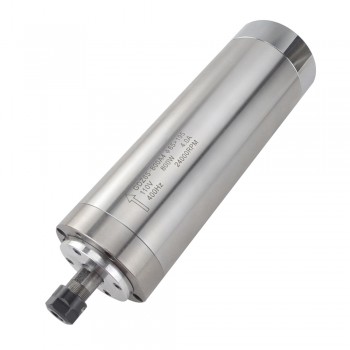1.Basic introduction of CNC spindle motor
A CNC spindle motor is the high-precision electric motor in a Computer Numerical Control (CNC) machine that rotates the cutting tool or workpiece at high speeds to perform operations like cutting, drilling, and milling with exceptional accuracy. These motors are engineered for high speed, high torque, and precision, often featuring specialized components like precision bearings and cooling systems (air or water) to handle the demands of machining different materials.

2.Components and principles of CNC spindle motor
1.Stator and Rotor: The stator contains stationary windings, and the rotor is the spinning part.
2.Magnetic Field: Electrical current passing through the stator windings creates a rotating magnetic field.
3.Torque Generation: This magnetic field interacts with the rotor, producing torque that causes the rotor and the connected spindle shaft to rotate.
4.Precision Bearings: High-precision bearings are crucial for supporting the rotor, ensuring smooth rotation, and minimizing vibration for high accuracy.
5.Tool Holder: The spindle shaft holds a tool holder that grips the cutting tool, which then engages the material to cut, drill, or engrave.
3.Design advantages of CNC spindle motor
1.Increased Speed and Productivity:CNC spindle motors can achieve very high rotational speeds, sometimes exceeding 60,000 RPM, which significantly boosts the speed of machining operations and reduces cycle times.This high speed enables faster material removal, leading to higher production volumes and increased overall productivity.
2.Greater Torque and Material Versatility:Higher torque output allows the motor to perform heavy cuts and remove large amounts of material without compromising speed or accuracy.Increased torque also facilitates the machining of a wider variety of materials, making the spindle motor more versatile.
3.Enhanced Precision and Reduced Vibration:The precise design of the spindle motor, including its bearings and rotor, minimizes vibration.Less vibration directly translates to a smoother surface finish on the machined parts and increased dimensional accuracy.
4.Improved Reliability and Longevity:Built with high-quality materials, CNC spindle motors are designed to withstand the demanding conditions of continuous industrial use.This durability contributes to increased reliability and a longer operational lifespan, reducing the frequency of failures and costly downtime.
5.Energy Efficiency and Versatility:Advanced designs, including efficient cooling systems, can contribute to energy efficiency in CNC spindle motors.Spindle motors come in various sizes and power ratings, making them adaptable and suitable for a wide range of machining applications, notes MRO Electric and Supply.

4.Maintenance tips of CNC spindle motor
1.Cleaning & Contamination Control:Use a clean cloth to wipe the spindle motor and tool cone to remove dust and debris. A soft-bristled brush or vacuum cleaner can also be used.Vacuum or clear any dust and dirt from the motor’s ventilation slots and heat sinks to prevent overheating.Keep the work area clean to minimize airborne contaminants that can damage the spindle motor.
2.Lubrication & Coolant Management:Ensure bearings are properly lubricated with the manufacturer-recommended lubricant to reduce friction and wear.For liquid-cooled spindles, check for proper coolant flow and ensure the coolant is clean, as contaminated coolant can cause internal damage.
3.Monitoring & Inspection:Monitor spindle temperature for any issues and listen for unusual noises like grinding or whining that could signal bearing wear or imbalance. Vibration testing is also a good diagnostic practice.For air-purged spindles, check that the air pressure is correct and the air quality is good, as moist or contaminated air can cause corrosion.Inspect the tool holder for dirt, debris, or corrosion to ensure an accurate and secure tool connection.
4.Operational Best Practices:Match the spindle’s specifications to the job to prevent overworking and reduce wear.Do not leave the spindle idle for extended periods; run it occasionally to prevent grease and oil from settling.Always refer to the spindle manufacturer’s specific recommendations for lubrication, maintenance, and operation.